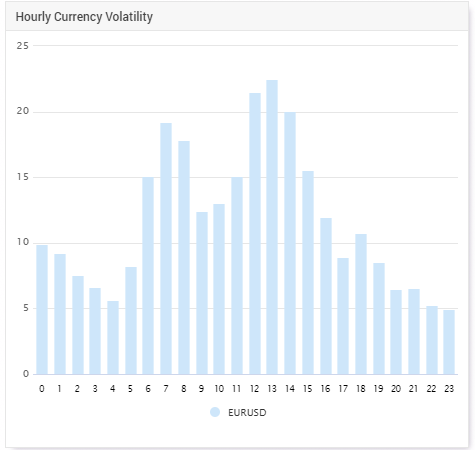Advertisement
Filtro de volatilidade
Volatilidade Forex
| Moeda | 1 minute | 5 minutos | 15 minutos | 30 minutos | 1 hora | 4 horas | Diariamente | Semanalmente | Mensalmente |
|---|---|---|---|---|---|---|---|---|---|
| AUDCAD | 1.9 | 5.0 | 13.1 | 15.9 | 19.8 | 70.8 | 117.7 | 590.2 | 188.3 |
| AUDJPY | 3.7 | 10.9 | 16.3 | 16.3 | 21.8 | 110.2 | 219.5 | 918.0 | 393.2 |
| AUDNZD | 1.8 | 4.3 | 5.4 | 6.1 | 8.4 | 42.7 | 84.7 | 326.6 | 206.6 |
| AUDUSD | 1.6 | 5.5 | 7.8 | 11.6 | 20.0 | 65.5 | 134.1 | 455.1 | 204.2 |
| CADJPY | 4.6 | 13.2 | 23.5 | 24.6 | 25.5 | 82.2 | 176.6 | 383.3 | 448.9 |
| EURAUD | 5.9 | 23.9 | 25.5 | 38.2 | 40.8 | 201.4 | 448.5 | 1305.5 | 701.7 |
| EURCAD | 6.9 | 22.1 | 28.4 | 34.7 | 34.7 | 135.9 | 301.4 | 362.9 | 854.0 |
| EURCHF | 1.1 | 4.9 | 10.8 | 16.4 | 16.4 | 42.5 | 193.9 | 336.0 | 316.3 |
| EURCZK | 73.2 | 110.9 | 142.4 | 142.4 | 316.5 | 1052.4 | 1111.2 | 3830.8 | 3017.8 |
| EURGBP | 1.8 | 7.7 | 8.5 | 14.0 | 16.6 | 45.0 | 147.8 | 209.6 | 201.5 |
| EURJPY | 2.8 | 7.6 | 19.8 | 29.0 | 29.0 | 139.6 | 169.8 | 596.8 | 859.2 |
| EURUSD | 4.9 | 10.8 | 12.2 | 24.0 | 36.6 | 99.4 | 311.8 | 368.6 | 566.2 |
| GBPJPY | 4.0 | 15.1 | 27.8 | 37.6 | 47.1 | 104.3 | 306.0 | 965.5 | 772.0 |
| GBPUSD | 3.9 | 6.7 | 9.7 | 15.9 | 22.4 | 94.2 | 175.9 | 382.6 | 440.4 |
| NZDUSD | 1.5 | 3.8 | 6.6 | 10.8 | 18.1 | 62.8 | 137.7 | 315.3 | 237.9 |
| USDCAD | 1.2 | 8.6 | 17.8 | 17.8 | 31.4 | 87.0 | 158.5 | 387.7 | 307.6 |
| USDCHF | 4.1 | 5.0 | 9.5 | 15.4 | 27.2 | 73.2 | 370.1 | 378.6 | 275.5 |
| USDJPY | 6.3 | 14.6 | 22.2 | 27.6 | 44.1 | 149.8 | 375.1 | 593.7 | 476.3 |
| XAGUSD | 1.5 | 4.1 | 7.1 | 8.7 | 15.1 | 90.1 | 73.9 | 613.0 | 346.0 |
| XAUUSD | 96.0 | 229.0 | 301.0 | 457.0 | 706.0 | 3295.0 | 11281.0 | 19064.0 | 26891.0 |
O que é volatilidade na negociação Forex
Volatilidade é um termo usado para descrever estatisticamente a variação nos preços de negociação. Quanto maior o número, maior é a volatilidade do mercado. Alternativamente, quanto menor o número, menor é a volatilidade.
Por exemplo, se EURUSD se move de 1,1200 para 1,1250, isso significa uma volatilidade de 50 pips ou 0,44%. Alternativamente, se GBPUSD mover de 1,3800 para 1,3900, isso representa uma volatilidade de 100 pips ou 0,72%. Olhando para os dois pares, agora pode comparar a volatilidade e dizer qual moeda é mais volátil durante o período inspecionado. É importante observar que os pips nem sempre são uma medida adequada para a volatilidade ao comparar pares com alta variação no valor do pip.
How is volatility measured?
Volatility is the difference between the high and low values of a price in a symbol. Some traders use indicators to measure volatility such as average true range (ATR), bollinger bands, moving averages or standard deviation, however at the table above you can quickly compare multiple symbols across different timeframes and thus save you time.
Why is volatility important?
Volatility tells you how drastically a certain currency has moved within a timeframe. This helps you adjust your trading systems and trading times to perfectly suit your trading style. Usually, a Forex trader looking for low and steady returns and less risk would prefer to trade low volatility pairs. On the other hand, traders that can accept higher risk would prefer to trade high volatility pairs to profit from the volatile price movements. Keep in mind that other factors such as your dimensão da posição deve fazer parte da sua gestão de risco.
What causes volatility of currency pairs?
Volatility represents the price movements of a currency due to the buy and sell orders. The more buying or selling pressure there is, it will quickly move to the appropriate direction.
This is of course mostly visible during important economic events of the related economies.
Qual o par Forex mais volátil
Normalmente os pares e cruzamentos exóticos são os mais voláteis no Forex. Isso deve-se às economias fracas, instáveis e que causam a flutuação volátil da moeda local. Os pares principais, mais negociados e das economias mais fortes, apresentam menor volatilidade, pois possuem economias estáveis e fortes.
Como usar a nossa volatilidade Forex?
Use the table to analyze, sort and compare the different volatility pairs. You can define min and max levels to easily filter out the irrelevant date for your trading strategy. Entering the volatility section of a specific currency will reveal an abundance of information such as hourly volatility, daily weekly and monthly volatility as well as the ability to compare all of these metrics against other symbols.











